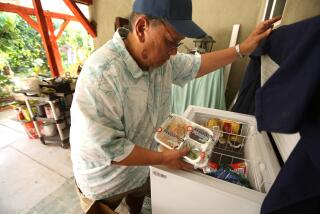Thousands of Seniors Are Missing Hot Meals : Economy: Programs that donate, deliver food lack funds. The elderly can become malnourished.
- Share via
WASHINGTON — Thousands of elderly Americans, home alone and too frail to cook, can’t get meals-on-wheels hot dinners because programs across the country are strapped for cash.
In Detroit alone, 1,500 seniors are waiting to get into a program that delivers 1,350 meals a day. The average wait is six months to a year.
Neighborhood meal sites for seniors are also shutting down by the dozens as federal spending on nutrition programs for the elderly fails to keep pace with rising costs and heightened demand from an aging population.
Advocates worry that growing numbers of seniors could wind up hospitalized or in nursing homes if they have to wait long to get on a meals-on-wheels route. Others may become malnourished if they lose their main meal of the day with the closing of a neighborhood nutrition site.
“We’re seeing very frail, very low-income . . . women, or men who never learned to cook for themselves,” said Toby Felcher, who is responsible for elderly nutrition services in Baltimore. “This program does exactly what it was supposed to do. We provide these basic services to keep people alive. And without food people don’t live.”
In Ft. Worth, Tex., where demand for home-delivered meals has risen 100% in five years, Carla Jutson says she is constantly juggling her caseload to find space in the program for the sickest seniors.
If someone gets well enough to use a cane, he or she is taken off the rolls to make room for the latest patient discharged from the hospital into an empty house with empty cupboards, said Jutson, executive director of Meals on Wheels Inc. of Tarrant County.
According to Susan Finn, president of the American Dietetic Assn., older Americans are at particular risk of malnutrition.
One-third of people over 65 skip at least one meal a day, and 25% have incomes under $10,000 a year, which “lends support to the fact that these programs are essential,” Finn said.
The federal departments of Agriculture and Health and Human Services spent a combined $620.4 million on senior nutrition programs in 1992, an increase of 8.2% from 1988. But consumer prices jumped 20% in the last five years and advocates say demands for hot-cooked meals grew even faster.
The number of federally funded meals, either delivered to homes or served at local meal sites, totaled about 253 million last year, up from 234 million five years ago, according to HHS figures.
Many local meal sites and meals-on-wheels programs receive federal funding, as well as state and local money and donations. Some home-delivered meal programs are privately funded.
Nationwide, meals-on-wheels programs had an average of 85 people on their waiting lists two years ago, according to a survey by the National Assn. of Meal Programs. Executive director Gail Martin said the situation has not improved.
Neighborhood meal sites have also been hard hit.
A survey by the National Assn. of Nutrition and Aging Service Programs found that 133 sites were closed in 1990 and 137 more were scheduled to be shut down in 1991.
Wesley Hofferber of Oklahoma’s Panhandle Nutrition Service says he’s not reaching everyone who needs a hot meal.
“It’s kind of a shame these people just fall through the cracks,” he said. “Some of these people, if it weren’t for the program, would be living in nursing homes today.”
More to Read
Sign up for Essential California
The most important California stories and recommendations in your inbox every morning.
You may occasionally receive promotional content from the Los Angeles Times.













